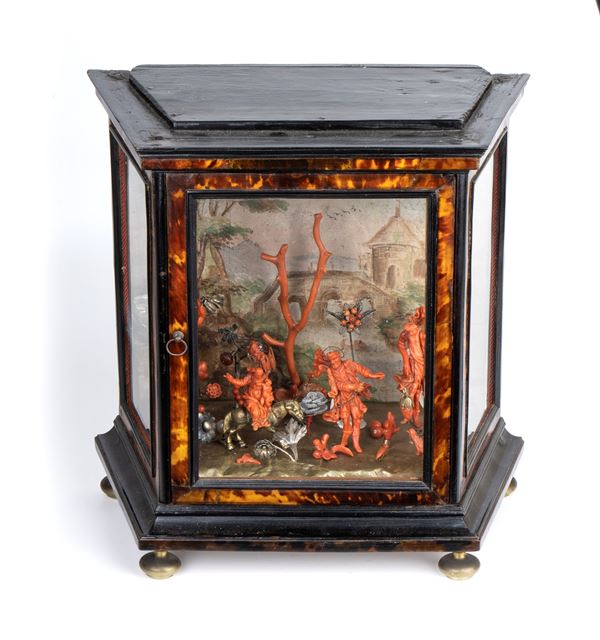An Italian carved coral, tortoiseshell and silver Nativity scene, Trapani, 17th-18th century
The nativity scene is housed in an ebonised wood and tortoiseshell case, resting on brass spinning feet.
The characters of the sacred representation, depicting the flight into Egypt, are portrayed in typical attitudes and are entirely sculpted in Mediterranean red coral (Corallum rubrum, Linnaeus 1758), which is also present in rough twigs, spheres, leaves and in long drops.
The work is set in a traditional architectural backdrop painted on panel depicting a wooded landscape with a bridge and a farmhouse.
The greatest moment of splendour in the art of the Trapani craftsmen was in the 17th and 18th centuries when the serial production of balls, olivettes, small ashlars and commas of the 14th, 15th and 16th centuries led to works of higher artistic value such as sculptures and compositions, often characterised by a rich architectural backdrop.
The Sicilian tradition of celebrating Christmas with the nativity scene led Trapani's masters to make both individual shepherds and nativity compositions of various sizes, with coral inserts, so much so that a document from 1571, the Account of the General Treasury of the Kingdom of Sicily, already mentions a coral Nativity. Trapani's artefacts were highly prized by Italian and foreign collectors, so much so that the most illustrious families owned valuable examples. In the Pepoli Museum in Trapani and the San Martino Museum in Naples, there are coral specimens, both made of gilded copper, silver, coral and enamels.
When coral began to become rarer towards the end of the 18th century, Trapani sculptors turned to other materials such as ivory or bone and the symptoms of the decline of the red material began to be felt, which became increasingly scarce until it almost disappeared. It will therefore be ivory that gradually replaces coral in nativity representations, coral reduced to a few elements as in the miniature nativity scene in the Burgio collection in Palermo, set in a silver frame with a garland of gradual flowers and leaves, attributed to the workshop of the brothers Alberto and Andrea Tipa.
Item condition grading: **** good, wear, losses and replacements.
Palermo, Li Vigni Collection.
Formerly on display in the Museo Diocesano di Monreale.




















